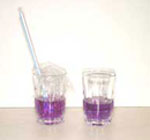CO2 Absorption - Experiment
Breathe in…Breathe out…Inhale…Exhale.…
This is something each of us does many times every minute of the day. With every breath we inhale, we remove oxygen from the air for our own use. With every breath we exhale, we add to the amount of carbon dioxide in the atmosphere. Carbon dioxide is one of the greenhouse gases, so named because it helps to keep earth’s heat from escaping into outer space.
Over the past several hundred years, the proportion of carbon dioxide in the atmosphere has been increasing. There are more people living on the surface of the earth now than ever before. In addition to more people exhaling, many of our industrial activities are adding carbon dioxide to the atmosphere, such as through the burning of fossil fuels. This increase in carbon dioxide is likely a major factor in the rising average temperature of the earth.
If the amount of carbon dioxide in the atmosphere continues to increase, it could have a major impact on our global climate and life as we know it. To prevent this, we can find ways to decrease our carbon dioxide production, mainly through regulating our industrial activities.
However, there is also the possibility of removing carbon dioxide from the air and storing it in other places, such as in plants, rock formations, or water. In this activity, you can experiment with storing some of your own carbon dioxide in water.
Tools and Materials
- two small transparent cups (about 100 ml or 3 ounces) or other similar containers
- drinking straw
- safety goggles
- sheet of paper or transparent plastic wrap
- paper towels
- pH indicator, such as cabbage water
What To Do
|
1. Prepare two small cups or containers of cabbage water. The initial purple color of the cabbage water indicates a pH of around 7.0, which is typical. |
|
|
|
2. Cover the mouth of one cup with paper or transparent plastic wrap. Insert a drinking straw and gently blow bubbles into the water for several minutes. We recommend the use of safety goggles for any activity in which liquid might splash into the eyes. 3. Compare the color of the bubbled cabbage water with the color of the cabbage water in the other cup. Compare your observations with our results. |
|
This content has been re-published with permission from SEED. Copyright © 2025 Schlumberger Excellence in Education Development (SEED), Inc.
Course:



